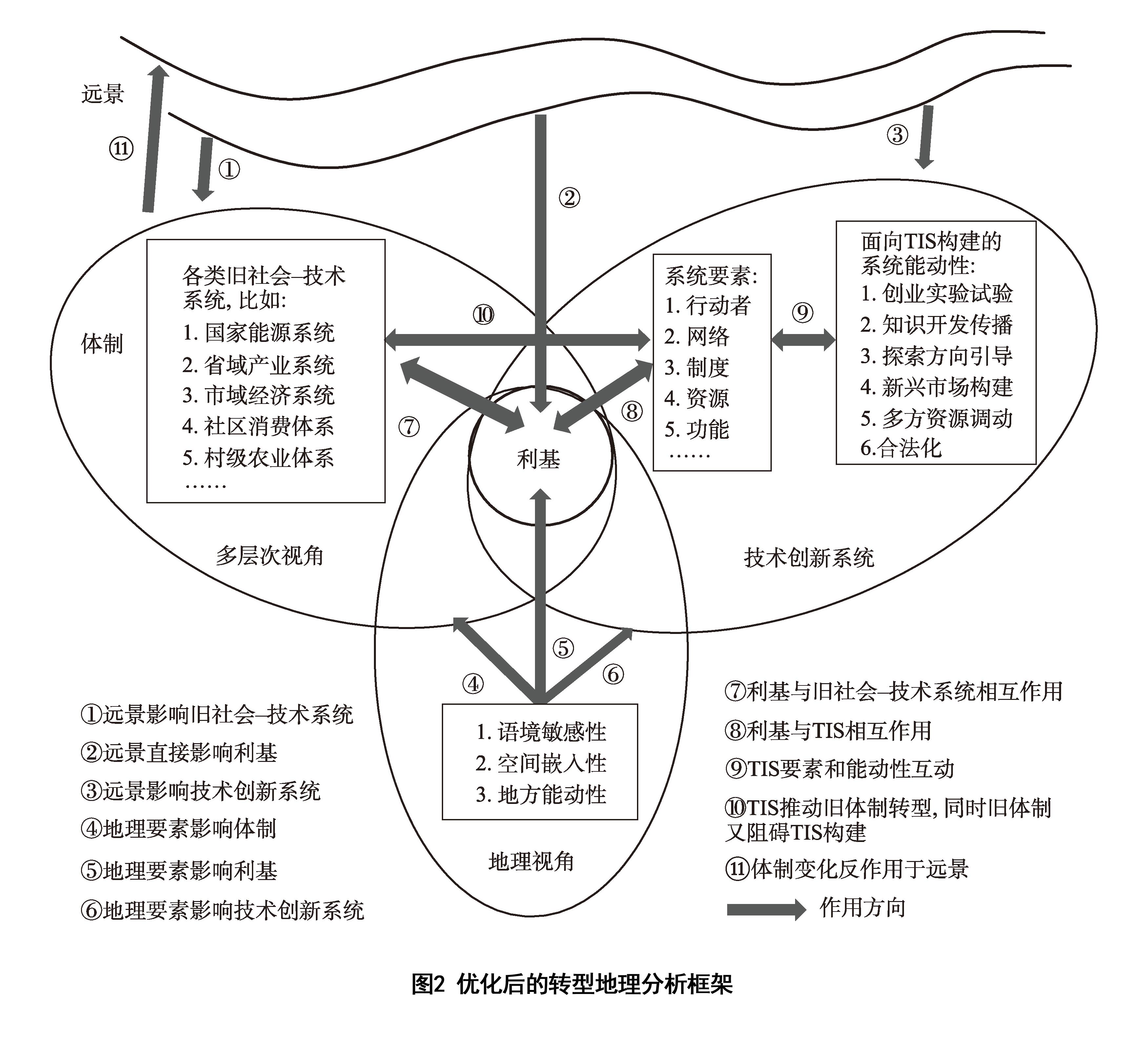

Geographical perspectives of sustainability transitions: Towards an advanced analytical framework
Received date: 2022-09-06
Revised date: 2022-12-28
Online published: 2023-04-13
In recent years, the concept of “sustainability of transitions” has entered the field of economic geography, which has been applied as an important perspective to explore the spatial dynamics of green technology emergence and to understand the mechanism of regional industrial evolution. This has brought about an emerging research theme named “geographies of transitions”. However, this research theme is characterized by the strong “concepts and analytical frameworks adopting” approach specializing in empirical examinations, lacking integration of multiple perspectives. Geographies of transition studies thus have been marginalized to the mainstream transition studies, which is not in favor of geographies of transition studies. This article combines three geographical concepts, namely, contextual sensitivity, spatial embeddedness, and place-based agency, with multi-level perspective (MLP) and technological innovation system (TIS), and constructs an improved analytical framework to better explain the mechanism differences in transitions among different geographical contexts. In so doing, an updated analytical framework is formed, which not only fits the mainstream ideas of sustainability transitions, but also closely reflects economic geographical questions. This framework highlights that: (1) Regional transition is a systematic process in which context, structure and agency interplay at multiple geographical scales. (2) The geographies of transitions are about the differences in degree, capacity, pathway and process of new socio-techno systems are socially embedded in existing regimes. (3) The objects of transitions are certain, and grounded, which is strongly linked with place-based agency who promote resource alignment and institutionization on the existing social-technological systems. Based on the above, this paper also offers an empirical illustration by adopting the updated analytical framework. It finanlly puts forward several research agendas for future's geographies of transitions research in China.

HU Xiaohui , ZHANG Xuliang , YANG Yu . Geographical perspectives of sustainability transitions: Towards an advanced analytical framework[J]. GEOGRAPHICAL RESEARCH, 2023 , 42(4) : 1117 -1129 . DOI: 10.11821/dlyj020220952
表1 可持续转型研究和转型地理研究的地理概念理解差异Tab. 1 The differences in geographical concepts between transitions studies and geographies of transitions |
| 概念理解 | 转型研究 | 转型地理研究 |
|---|---|---|
| 尺度 | 特定边界的抽象地域类型,或给定的分析单元。 | 社会构建的、多主体介入的、跨多地理尺度和制度边界的动态载体。 |
| 地方 | 涉及转型发生位置,是去语境化的。是一个重要的分析对象和单元,但却忽视地方特性。 | 既是地理位置,又有具体内涵,指转型所涉及的个体、组织、物质、文化、历史和结构,及相互关系所形成的地方特有语境。也受宏观语境影响,如社会观念、国家政策和文化特征等。 |
| 空间 | 新技术实验发展的保护空间或知识传播空间,多指理解转型的分析对象(如利基),不具备地理性。 | 强调转型空间差异问题,多指不同国家和区域语境下,转型过程、社会经济和环境效益出现不同,存在不同模式。 |
注:作者根据文献整理。 |
真诚感谢匿名评审专家在论文评审中所付出的时间和精力,专家对本文理论框架研究思路、视角融合建议、实际案例说明、结论梳理方面的修改意见,使本文获益匪浅。
| [1] |
|
| [2] |
|
| [3] |
|
| [4] |
余振, 龚惠文, 胡晓辉. 可持续性转型地理研究综述与展望. 地理科学进展, 2021, 40(3): 498-510.
[
|
| [5] |
|
| [6] |
贺灿飞, 李伟. 演化经济地理学与区域发展. 区域经济评论, 2020(1): 39-54.
[
|
| [7] |
朱晟君, 黄永源, 胡晓辉. 多尺度视角下的产业价值链与空间升级研究框架与展望. 地理科学进展, 2020, 39(8): 1367-1384.
[
|
| [8] |
赵建吉, 王艳华, 苗长虹. 区域新兴产业形成机理: 演化经济地理学的视角. 经济地理, 2019, 39(6): 36-45.
[
|
| [9] |
|
| [10] |
胡晓辉, 董柯. 可持续性转型研究动态与经济地理学展望. 地理研究, 2022, 41(1): 18-33.
[
|
| [11] |
胡晓辉, 朱晟君,Robert Hassink. 超越“演化”: 老工业区重构研究进展与范式反思. 地理研究, 2020, 39(5): 1028-1044.
[
|
| [12] |
|
| [13] |
|
| [14] |
|
| [15] |
|
| [16] |
|
| [17] |
|
| [18] |
|
| [19] |
|
| [20] |
|
| [21] |
|
| [22] |
|
| [23] |
|
| [24] |
|
| [25] |
|
| [26] |
|
| [27] |
|
| [28] |
|
| [29] |
|
| [30] |
|
| [31] |
|
| [32] |
|
| [33] |
|
| [34] |
|
| [35] |
|
| [36] |
|
| [37] |
|
| [38] |
|
| [39] |
|
| [40] |
|
| [41] |
|
| [42] |
|
| [43] |
|
| [44] |
|
| [45] |
|
| [46] |
|
| [47] |
|
| [48] |
|
| [49] |
|
| [50] |
|
| [51] |
|
| [52] |
|
| [53] |
|
| [54] |
贺灿飞, 毛熙彦, 彭建. 环境经济地理研究的理论演进与展望. 经济地理, 2021, 41(10): 70-78.
[
|
| [55] |
|
| [56] |
金璐璐, 贺灿飞, 周沂, 等. 中国区域产业结构演化的路径突破. 地理科学进展, 2017, 36(8): 974-985.
[
|
| [57] |
贺灿飞. 区域产业发展演化: 路径依赖还是路径创造?. 地理研究, 2018, 37(7): 1253-1267.
[
|
| [58] |
汪明峰, 郗厚雪. 城市新兴技术产业的演化路径比较分析: 以长三角物联网产业为例. 地理研究, 2015, 34(9): 1697-1707.
[
|
| [59] |
胡晓辉, 张文忠. 制度演化与区域经济弹性: 两个资源枯竭型城市的比较. 地理研究, 2018, 37(7): 1308-1319.
[
|
| [60] |
苏灿, 曾刚. 演化经济地理学视角下区域新路径发展的研究评述与展望. 经济地理, 2021, 41(2): 23-34.
[
|
| [61] |
吴頔, 丁婧, 袁丰. 政府能动性对外部冲击型战略耦合断裂的暂时性调节研究: 以江苏省昆山市为例. 地理研究, 2021, 40(12): 3470-3482.
[
|
| [62] |
余振, 黄平, 龚惠文. 绿色机会窗口与后发城市可持续性转型. 中国人口·资源与环境, 2022, 32(6): 94-103.
[
|
| [63] |
|
| [64] |
沈静, 王少谷, 周楚平. 环境公正视角下广州污染企业分布与区域人口社会特征的时空关系研究. 地理研究, 2022, 41(1): 46-62.
[
|
| [65] |
毛熙彦, 贺灿飞. 环境经济地理学的研究现状与挑战. 地理研究, 2022, 41(1): 4-17.
[
|
/
| 〈 |
|
〉 |